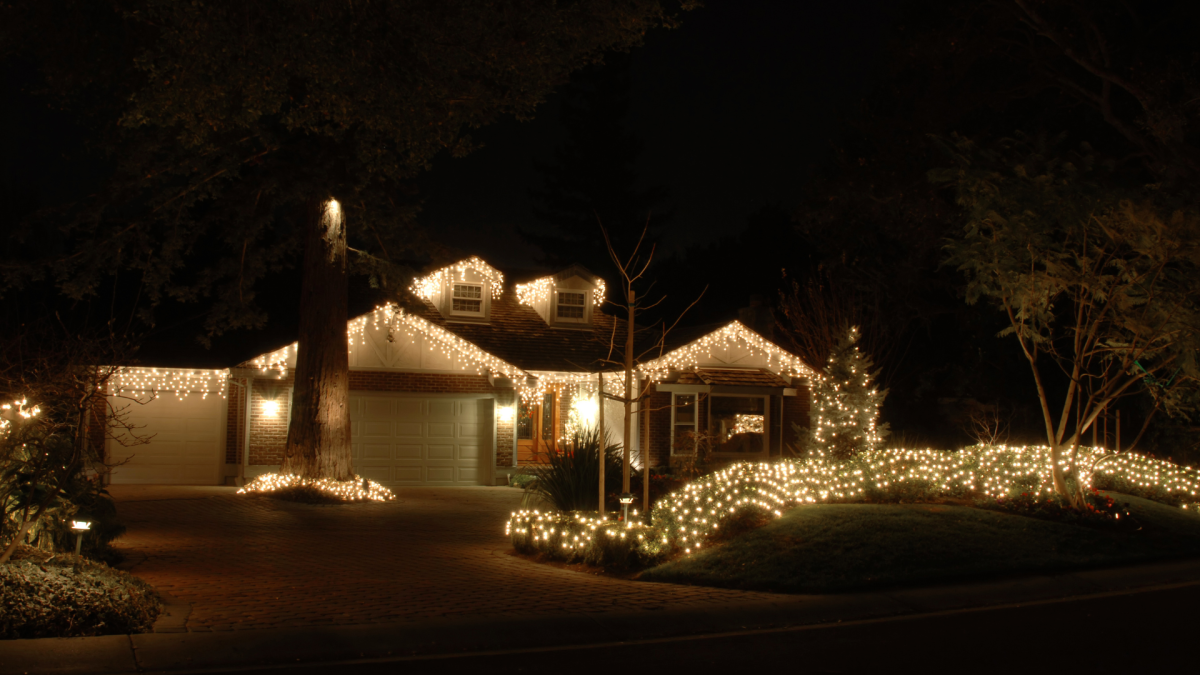Professional holiday lighting providers throughout the Toledo area increasingly emphasize comprehensive design consultation as a critical component of successful installations. Rather than treating seasonal displays as purely technical projects, established companies approach holiday lighting as an aesthetic discipline requiring architectural assessment, style coordination, and strategic planning.
This design-centered methodology addresses common disappointments homeowners experience when holiday lighting fails to match their expectations. Random light placement, inconsistent coverage, clashing color combinations, and displays that overwhelm rather than enhance architecture represent frequent outcomes when installation proceeds without thoughtful planning. Understanding how professional design improves results helps property owners recognize the value proposition beyond basic installation services.
Common Design Challenges Affecting Holiday Displays
Homeowners across Toledo, Maumee, Perrysburg, and surrounding communities often struggle translating their vision for holiday lighting into reality. The disconnect between imagination and execution stems from several factors that professional design consultation specifically addresses.
Architectural complexity presents the primary challenge. Toledo area homes span diverse styles including Colonial, Victorian, Ranch, Cape Cod, and Contemporary designs. Each architectural style has distinctive features that respond differently to various lighting approaches. What enhances a Victorian home's ornate details may overwhelm a Ranch home's horizontal simplicity. Without understanding these relationships, installations often feel mismatched to their settings.
Scale perception difficulties complicate planning. Homeowners visualizing lighting coverage from ground level struggle accurately estimating how displays will appear from street perspectives after dark. Light quantities that seem appropriate during daylight planning often prove insufficient for desired visual impact. Conversely, excessive coverage can create garish results that detract from architectural beauty rather than enhancing it.
Color selection represents another common stumbling point. The proliferation of LED options beyond traditional white and multicolor creates decision complexity. Warm white versus cool white, single colors versus color-changing systems, and accent color coordination all affect overall aesthetic outcomes. Without guidance based on architectural style, landscape features, and neighborhood context, these choices often produce disjointed results.
Feature prioritization requires strategic thinking. Most properties have multiple potential focal points including entryways, prominent trees, architectural details, landscape beds, and hardscape elements. Determining which features merit emphasis and which should remain secondary involves understanding visual hierarchy principles and sight line dynamics. Amateur approaches often attempt illuminating everything equally, creating visual confusion rather than intentional design.
Professional Design Consultation Process
Comprehensive design consultation begins with detailed property assessment. Experienced designers walk properties systematically, photographing architectural features, noting landscape elements, observing surrounding context, and discussing homeowner preferences. This evaluation identifies opportunities and constraints that inform subsequent planning.
Architectural analysis forms the foundation of effective design. Designers assess roofline complexity, window and door configurations, prominent features like columns or dormers, and overall style characteristics. This analysis determines appropriate lighting densities, optimal placement patterns, and techniques that complement rather than fight architectural intentions.
Landscape integration represents a frequently overlooked design dimension. Professional approaches consider how holiday lighting interacts with existing landscape features including specimen trees, shrub masses, hardscape elements, and permanent outdoor lighting systems. Coordinated design creates cohesive outdoor environments rather than disconnected seasonal additions that ignore underlying landscape structure.
Style preference discussions help designers understand homeowner aspirations. Some clients prefer classic elegance emphasizing architectural lines with restrained white lighting. Others envision traditional festive displays incorporating multicolor elements and abundant coverage. Contemporary minimalist approaches appeal to homeowners seeking subtle sophistication. Understanding these preferences allows designers to develop concepts aligned with client aesthetics rather than imposing predetermined formulas.
Viewing perspective analysis ensures designs deliver intended impact from relevant vantage points. Designers consider street-level views where most display appreciation occurs, evaluating how lighting will appear from various approach angles. They identify which features naturally draw attention and which elements require emphasis to achieve balanced composition.
Visualization Technology and Design Communication
Advanced visualization tools have transformed how professional designers communicate concepts to clients. These technologies bridge the gap between verbal descriptions and actual installation appearance, allowing homeowners to make confident decisions before any physical work begins.
Two-dimensional design plans provide overhead perspectives showing lighting placement, connection routing, and coverage areas. These technical documents help homeowners understand installation logistics including outlet locations, extension cord requirements, and how various display components interconnect. Plans also serve as installation guides ensuring field crews execute designs as intended.
Three-dimensional rendering technology offers more intuitive visualization. Digital models incorporating actual property photographs show how proposed lighting will appear after dark from street level. Homeowners can evaluate different color options, coverage densities, and feature emphasis approaches by comparing rendered alternatives. This visualization prevents disappointments that occur when imagination doesn't match reality.
Interactive design processes allow iterative refinement. Initial concepts based on consultation discussions provide starting points for modification. Clients can request adjustments to coverage areas, color selections, or feature emphasis. Designers incorporate feedback and generate updated visualizations until concepts align completely with homeowner vision. Rock Solid Landscape exemplifies this collaborative approach, utilizing rendering technology to ensure customer satisfaction before installation begins.
Material selection guidance represents another consultation component. Commercial-grade LED systems offer various characteristics including brightness levels, color temperature options, and beam spread patterns. Designers explain how these technical specifications affect aesthetic outcomes, helping clients select materials appropriate for their specific design goals and architectural context.
Architectural Style Considerations
Different architectural styles respond optimally to distinct lighting approaches. Professional designers develop recommendations based on style-specific best practices refined through hundreds of installations.
Traditional homes including Colonial and Victorian styles often benefit from approaches emphasizing architectural detail. Roofline lighting outlining complex configurations, window frame accent lighting, and column emphasis create elegant results that enhance rather than obscure ornate features. Warm white lighting typically complements traditional architecture better than stark cool white options.
Contemporary homes with clean lines and minimalist aesthetics call for restrained approaches. Strategic accent lighting highlighting specific features rather than comprehensive coverage maintains architectural integrity. Cool white and single-color schemes often suit modern design sensibilities better than multicolor traditional approaches.
Ranch-style homes with horizontal emphasis benefit from techniques that respect their inherent proportions. Ground-level landscape lighting and foundation plantings illumination balance roofline coverage, preventing top-heavy appearances. Pathway lighting extending horizontal lines reinforces rather than contradicts architectural character.
Cape Cod and Cottage styles often accommodate more playful, abundant approaches. Their informal character tolerates traditional multicolor schemes and comprehensive coverage that might overwhelm more formal architectural styles. Window emphasis and dormers illumination enhance charm inherent to these designs.
Integration With Landscape Design Principles
Professional holiday lighting design extends beyond architecture to encompass broader landscape contexts. This integrated approach creates cohesive outdoor environments rather than isolated seasonal additions.
Specimen tree illumination provides dramatic focal points when executed thoughtfully. Designers consider tree species, branching structure, size, and position relative to architecture. Wrapping techniques, uplighting approaches, and canopy illumination each create distinct effects appropriate for different situations. Strategic tree lighting adds depth and visual interest beyond purely architectural coverage.
Hardscape element integration enhances overall design cohesion. Patios, walkways, retaining walls, and other constructed features often benefit from accent lighting that continues holiday themes throughout outdoor spaces. This expanded coverage creates immersive environments rather than limiting displays to building facades.
Foundation planting illumination provides transition between architectural lighting and ground level. Highlighting evergreen shrubs and ornamental plantings extends visual interest downward, preventing stark contrasts between illuminated rooflines and dark foundations. Comprehensive landscape design services inform these integrated approaches, ensuring seasonal additions complement year-round outdoor environments.
Sight line management considers how holiday lighting interacts with existing landscape features. Designers position elements to avoid visual conflicts with specimen plantings, maintain important views, and create intended focal point hierarchies. This attention to spatial relationships prevents cluttered appearances that compromise both holiday displays and underlying landscape investments.
Color Psychology and Design Impact
Color selection significantly affects display mood and appropriateness. Professional designers understand psychological associations and contextual considerations informing effective color choices.
Warm white lighting creates classic, elegant atmospheres associated with sophistication and timeless beauty. Its slightly amber cast complements traditional architecture and creates cozy, inviting impressions. This option suits homeowners preferring understated sophistication over bold festivity.
Cool white lighting produces crisp, contemporary aesthetics associated with modern design sensibilities. Its blue-white appearance creates winter wonderland effects and complements contemporary architecture. However, its stark quality can feel cold if not balanced appropriately with warmer elements.
Traditional multicolor approaches evoke nostalgia and family-focused celebration. Red, green, blue, and amber combinations create festive, approachable displays particularly suitable for families with children. This classic approach works best with informal architectural styles that accommodate playful elements.
Single-color schemes offer sophisticated alternatives to multicolor approaches. All-blue displays create serene winter themes. All-red provides bold drama. All-amber produces warm traditional effects without multicolor complexity. These monochromatic approaches suit various architectural styles when selected appropriately.
Color-changing LED technology provides maximum flexibility, allowing display moods to shift throughout the season. Systems can transition from autumn-appropriate warm tones through Thanksgiving, to traditional holiday colors, and potentially to celebratory New Year's palettes. This adaptability appeals to homeowners seeking dynamic rather than static displays.
Implementation Excellence and Design Realization
Superior design concepts require skilled implementation to achieve intended results. Professional installation crews trained in design principles understand that placement precision, symmetry maintenance, and attention to detail separate adequate execution from excellent outcomes.
For consultation regarding design approaches specific to individual properties, Toledo area homeowners can contact Rock Solid Landscape at 419-330-1610 or visit myrocksolidlandscape.com to explore design capabilities and view previous installation examples.





